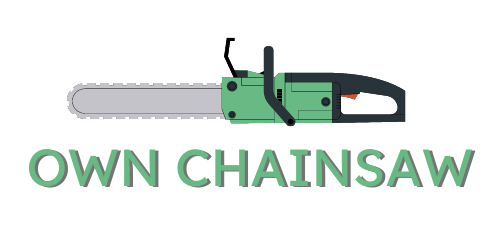For those who work in the lumber industry or enjoy DIY projects, cutting wood is a familiar task. However, cutting wet wood can pose some difficulties. Many ask, “Can a chainsaw be used to cut wet wood?” The answer is a conclusive yes.
Nevertheless, as with any tool, there are certain factors to consider. The added weight and density of wet wood can make it more challenging to cut, and chainsaws need extra care to prevent damage.
So, here will explore the essential dos and don’ts of cutting wet wood with a chainsaw to help you work smarter, not harder.

Will Cutting Wet Wood Damage My Chainsaw?
Cutting through wet wood using a chainsaw is a common chore that many homeowners undertake, particularly after a storm or heavy rainfall.
It’s essential to understand whether the moisture in the timber could harm the chainsaw or impact its efficiency. Fortunately, cutting wet wood with a chainsaw does not damage the tool in any way.
The chainsaw’s engine and cutting mechanism are designed to effortlessly handle different types of wood, even damp ones.
Damp wood does not impede the cutting process in any way. The chainsaw has no difficulty slicing through it since it presents no additional resistance.
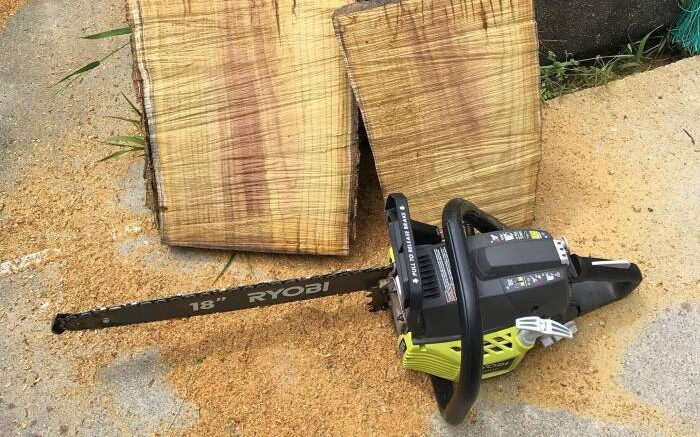
One concern for chainsaw operators is wet wood. The moisture in the wood causes sawdust to stick to the chain rather than being expelled by the air filter and exhaust. The result is a reduction in cutting force.
To ensure that the chainsaw’s cutting force remains as strong as possible, it is important to remove the sawdust that accumulates on the chain.
Is there a difference between cutting wet and dry wood with a chainsaw?
When it comes to cutting wood with a chainsaw, there are several factors to consider, and moisture content is one of them.
Wet Wood has a higher moisture content compared to dry wood, and this varies based on the species, location, weather conditions, and wood density.
Given this, it’s much easier to cut through wet wood than dry wood since the moisture reduces friction between the chain and the wood fibers.
Apart from moisture content, the age and density of the wood also determine how challenging it is to cut a piece of wood. However, if two pieces of the same wood species are available, one of them will be easier to work with if it’s damp.
The reason is that the chainsaw’s blade glides effortlessly through wet wood without resistance, making the cutting process a breeze.
Can you use a chainsaw in the rain?
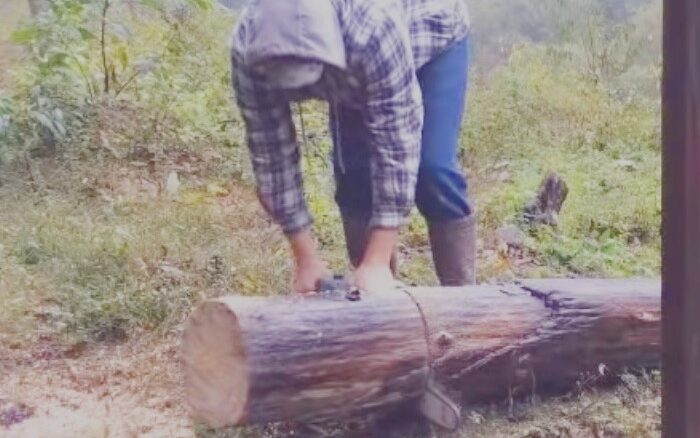
Using a chainsaw during a rainy day can be quite a challenge. Although you can use a gas engine-powered chainsaw in the rain, it is not recommended for you to use a battery-powered chainsaw because water can damage its electrical components.
Despite that, taking proper precautions is crucial to ensure your safety and the chainsaw’s protection from any damage.
To shield the engine from water infiltration, you can cover it with plastic. By doing so, the engine will be safe from water damage and will continue to operate smoothly.
Apart from covering the engine, it is equally vital to avoid submerging the chainsaw in water. Not only can it cause irreparable damage to the machine, but it can also put the user’s safety in jeopardy.
One of the biggest concerns when using a chainsaw in the rain is personal safety. Wet conditions can make it difficult to maintain a good grip on the chainsaw, which can lead to accidents.
When using a chainsaw, it is important to wear appropriate safety gear, including gloves, eye protection, and non-slip boots. In addition, it is important to use the chainsaw with caution and avoid making sudden movements that can cause the chainsaw to slip or kick back.
Does cutting wet wood dull a chainsaw?
It is a commonly held belief that using a chainsaw to cut through wet wood will inevitably lead to a dull chain. However, this myth is far from the truth.
Chainsaws are built to handle all types of wood, even damp or wet ones. The primary concern when dealing with wet wood lies in the added weight and the potential for excessive vibration, which can be easily mitigated with the right technique.
Despite what most people may think, a chainsaw chain is best operated when wet. The mineral oil utilized for chain lubrication forms a defensive barrier between the wood and the chain.
This, in turn, reduces friction and prevents overheating. Additionally, the oil helps to keep the chainsaw chain cool, which is essential for maintaining its sharpness and effectiveness over time.
When it comes to cutting wood, it’s always best to be cautious. One way to determine the wood’s safety is by using a moisture meter. This nifty device measures the moisture content of the wood, providing you with an accurate reading of its condition.
If the wood is too moist, it might need to dry out before you can safely operate the chainsaw. Wet wood is bulkier, harder to cut, and may cause excessive vibrations during chainsaw use.
Excessive vibration is a significant concern when cutting wet wood. Vibrations can cause the chainsaw to become unstable, leading to accidents and injuries.
To prevent this from happening, it is essential to use the proper technique when operating the chainsaw. This includes holding the saw steady and maintaining a firm grip on the handle at all times.
What chain to use for cutting wet wood?
Proper selection of the saw chain is crucial when it comes to cutting wet wood. The use of an incompatible chain can lead to a significant decline in performance, hasten the wear and tear, and impede the cutting process.
A majority of modern-day high-quality chainsaws can efficiently cut through wet wood when equipped with a regular saw chain.
With appropriate sharpening, lubrication, and upkeep, a standard saw chain is capable of effortlessly cutting through wet wood, much like it does with dry wood.
Wet wood can be difficult to cut with a chain that is not sharp enough or is improperly maintained.
It might be best to use a tiny chisel chain on damp wood that is particularly dense. Chains designed for handling dense and wet wood are called tiny chisel chains. It has a narrower tooth angle than a standard saw chain, increasing cutting speed and reducing wear.
Additionally, a tiny chisel chain has a smaller chip space between the teeth, which increases the amount of pressure exerted on the wood, making it easier to cut through.
How to clean a wet chainsaw?
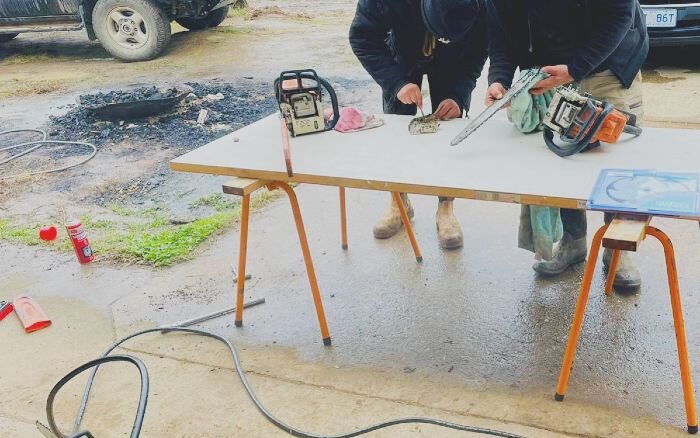
Cleaning a wet chainsaw is a crucial task that should not be overlooked. Moisture can cause rust and corrosion on the metal parts of the chainsaw, which can eventually lead to damage and reduced performance.
Here are the steps to properly clean a wet chainsaw:
1. Safety first – Before you start cleaning the chainsaw, make sure it is turned off and the power cord is unplugged. Wear protective gloves and safety goggles to prevent any accidents.
2. Remove the chain – Loosen the chain tension and remove it from the chainsaw. This will allow you to clean the chain and the bar separately.
3. Clean the bar – Use a clean cloth or brush to wipe down the bar of the chainsaw. You can also use a mild detergent solution to remove any grime or dirt.
4. Dry the chain – Use a clean cloth to dry the chain thoroughly. Make sure there is no moisture left on the chain before you reattach it to the chainsaw.
5. Lubricate the chain – Apply a generous amount of lubricant to the chain and bar. This will help protect the chainsaw from rust and corrosion.
6. Reassemble the chainsaw – Once the chain and bar are dry and lubricated, reattach the chain to the chainsaw and tighten the tension.
7. Store the chainsaw properly – After cleaning and lubricating the chainsaw, store it in a dry and cool place to prevent moisture buildup.
Precautions to take when cutting wet wood:
Cutting wet wood can be a challenging task as it poses certain risks to the person cutting the wood.
Wet wood is heavier and more difficult to handle than dry wood, and it can be more dangerous to cut due to the risk of slipping or the saw blade getting stuck in the wood.
Here are some things to keep in mind when cutting wet wood:
1. Wear Protective Gear – Always wear protective gear when cutting wet wood, including safety glasses, a dust mask, and gloves. As a result, you will be protected from flying debris and sawdust, as well as from splinters.
2. Use a Proper Saw – Use a saw with a sharp blade that is designed for cutting wet wood. The task will be easier and safer if you use a saw designed for wet wood instead of one with a dull blade.
3. Secure the Wood – Ensure that the wood is securely fastened before cutting. Use clamps or a vice to hold wet wood in place while you cut so it doesn’t slip or move.
4. Take Your Time – The process of cutting wet wood requires more patience and effort than cutting dry wood. If you are not comfortable using the saw, take your time.
5. Cut with the Grain – Always cut with the grain of the wood to prevent the blade from getting stuck or jumping out of the cut.
6. Watch for Knots – The blade often jumps or kicks back when cutting wet wood due to knots. Cut carefully through these knots.
FAQs
Should I let wet wood dry before I cut it with a chainsaw?
Ideally, it is best to allow wet wood to dry before cutting to reduce the risk of accidents and damage to the chainsaw. However, if you need to cut the wood immediately, take extra precautions and follow safe chainsaw operation practices.
How can I minimize kickback when cutting wet wood?
To minimize the risk of kickback while cutting wet wood, make sure that the chain is properly adjusted and sharpened. When cutting material, use a spreader to prevent jamming or kicking back. The chain brake should also be functioning properly, and the saw should be properly lubricated.
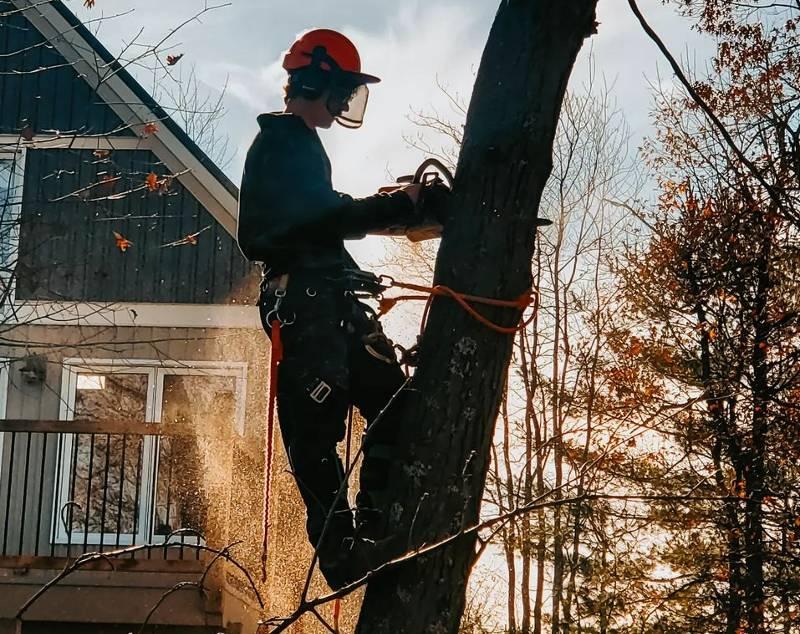
I am Senior Editor and CEO and I have been a chainsaw enthusiast for over 12 years. As a passionate chainsaw enthusiast, I have got a wealth of knowledge and experience with chainsaws, and I am constantly striving to expand my expertise and knowledge. Read More!
